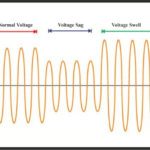What is Crest Factor in electricity?
Crest factor is defined as the ratio of the peak value of an electrical waveform to its RMS value. In other words, it is the ratio of the highest point of the waveform to the average value of the waveform over a given period. The crest factor is a measure of how far the waveform deviates from its average value.
The crest factor is often expressed in decibels (dB), which is a logarithmic unit of measurement that compares the amplitude of a signal to a reference level. In decibels, the crest factor is calculated as 20 times the logarithm base 10 of the ratio of the peak value to the RMS value.
How to calculate Crest Factor?
To calculate the crest factor, you first need to find the peak value and the RMS value of the waveform. The peak value is the highest point of the waveform, while the RMS value is the square root of the average of the squared values of the waveform over a given period. The crest factor is then calculated by dividing the peak value by the RMS value.
Crest Factor = Peak Value / RMS Value
In decibels, the crest factor is calculated as:
Crest Factor (dB) = 20 log10 (Peak Value / RMS Value)
Significance of Crest Factor:
The crest factor is an important parameter in many areas of electrical engineering and electronics. It is used to characterize the shape of electrical waveforms and can provide important information about the performance of electrical systems.
In power systems, crest factor is used to determine the maximum voltage that a system can handle without causing damage to the equipment. A high crest factor indicates that the waveform is highly peaked, which can cause problems with power transmission and distribution. It can also cause equipment failure due to excessive heating or voltage stress.
In audio systems, crest factor is used to measure the dynamic range of a signal. A high crest factor indicates a large dynamic range, which can be desirable in some audio applications, such as music recording and playback. However, a high crest factor can also cause problems with audio equipment, such as clipping and distortion.

What happen when Crest Factor increases?
When the crest factor increases, it indicates that the waveform is becoming more peaked, which means that the peaks of the waveform are becoming higher in relation to the average value of the waveform. This can have several consequences depending on the application and the specific characteristics of the waveform.
In power systems, a high crest factor can lead to equipment failure due to excessive heating or voltage stress. This is because the higher peak values of the waveform can cause voltage spikes and overvoltages that can damage sensitive equipment. High crest factor can also cause power transmission and distribution issues, leading to instability and inefficiency in the system.
In audio systems, a high crest factor can cause distortion and clipping, which can affect the quality of the audio signal. This is because the high peaks of the waveform can cause the signal to exceed the dynamic range of the audio equipment, leading to distortion and clipping.
In some applications, a high crest factor can be desirable, such as in music recording and playback. This is because a high crest factor can provide a large dynamic range, which can result in a more natural and realistic sound. However, in these cases, care must be taken to ensure that the audio equipment can handle the high peak values of the waveform without causing distortion or clipping.
Overall, a high crest factor can have various effects depending on the application and the specific waveform characteristics. It is important to understand and monitor the crest factor in electrical and audio systems to ensure optimal performance and prevent equipment failure or distortion.
How to improve Crest Factor?
Improving the crest factor of an electrical waveform can be achieved through several methods depending on the specific application and waveform characteristics. Here are a few general approaches that can be taken:
- Use a different waveform: In some applications, it may be possible to use a different waveform that has a lower crest factor. For example, a sine wave has a crest factor of 1, which means it has no peaks. If the application can tolerate a different waveform shape, using a sine wave or a waveform with a lower crest factor can be an effective solution.
- Increase the average value of the waveform: By increasing the average value of the waveform, the peaks become less pronounced, resulting in a lower crest factor. This can be achieved through various methods, such as using a DC offset or adjusting the bias level of the signal.
- Reduce the peak values of the waveform: Reducing the peak values of the waveform can also lower the crest factor. This can be achieved through various methods, such as using a limiter or a compressor to reduce the dynamic range of the signal.
- Use signal processing techniques: Signal processing techniques such as filtering, equalization, and dynamic range compression can also be used to improve the crest factor of an electrical waveform. For example, a low-pass filter can remove high-frequency components that contribute to the peaks of the waveform, resulting in a lower crest factor.
- Adjust the system parameters: In some cases, adjusting the system parameters such as the gain, impedance, or load can also improve the crest factor. For example, reducing the impedance of the system can reduce the voltage drop across the system, resulting in a lower crest factor.
In summary, improving the crest factor of an electrical waveform can be achieved through various methods depending on the specific application and waveform characteristics. Experimenting with different approaches and analyzing the results can help identify the most effective solution





